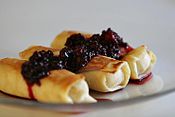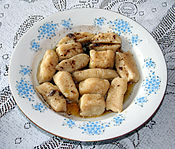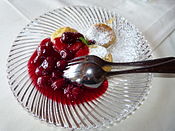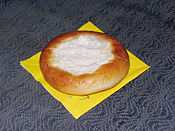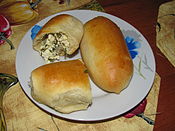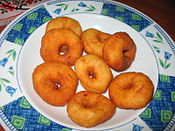Quark (dairy product)
This lead needs additional citations for verification. (May 2018) |

Quark or quarg is a type of fresh
Quark is traditional in the cuisines of Baltic, Germanic and Slavic-speaking countries as well as amongst Ashkenazi Jews and various Turkic peoples.
Dictionaries sometimes translate it as curd cheese,
Quark is similar to French
Name
Quark is possibly described by
Although quark is sometimes referred to loosely as a type of "cottage cheese", they can be distinguished by the different production aspects and textural quality, with the cottage cheese grains described as more chewy or meaty.[3]
Etymology
The word Quark (Late
The original
More cognates and forms
The Slavic words may also be cognate with the Greek name for cheese, τῡρός (tūrós).[13][15] A cognate term for quark, túró, is used in Hungarian.
Cognates also occur in Scandinavia (Danish kvark, Norwegian and Swedish kvarg) and the Netherlands (Dutch kwark). The Old English form is geþweor.[4]
Other German forms include Quarck,[16] and Quaergel (Quärgel).[17]

Other names
In several languages quark is also known as "white cheese" (
In Israel,
In Austria, the name Topfen (
Production

Quark is a member of the
Manufacture of quark normally uses
In Germany, it is continuously stirred to prevent hardening, resulting in a thick, creamy texture.[28] According to German regulations on cheese (Käseverordnung), "fresh cheeses" (Frischkäse) such as quark or cottage cheese must contain at least 73% water in the fat-free component.[21] German quark is usually sold in plastic tubs. This type of quark has the firmness of sour cream but is slightly drier, resulting in a somewhat crumbly texture (like ricotta).[28]
Basic quark contains about 0.2% fat; this basic quark or skimmed quark (Magerquark) must under German law have less than 10% fat by
Quark may be flavored with herbs, spices, or fruit.[28] In general, the dry mass of quark has 1% to 40% fat;[28] most of the rest is protein (80% of which is casein), calcium, and phosphate.
In the 19th century, there was no industrial production of quark (as end-product) and it was produced entirely for home use.[31] In the traditional home-made process, the milk would be allowed to let stand until it soured naturally by the presence of naturally occurring bacteria, although the hardening could be encouraged with the addition of some rennet.[22][31]
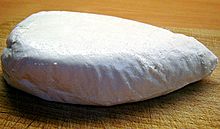
Some or most of the whey is removed to standardize the quark to the desired thickness. Traditionally, this is done by hanging the cheese in a muslin bag[23][32] or a loosely woven cotton gauze called cheesecloth and letting the whey drip off,[33] which gives quark its distinctive shape of a wedge with rounded edges. In industrial production, however, cheese is separated from whey in a centrifuge and later formed into blocks.[23]
Variations in quark preparation occur across different regions of Germany and Austria.[28] Most of the Austrian and other Central and Eastern European varieties contain less whey and are therefore drier and more solid than the German and Scandinavian ones.
In the Netherlands, many products labelled "kwark" are not based on quark as described in this article (fresh acid-set cheese), but instead a thick yogurt-like product made using yogurt bacteria (such as Streptococcus thermophilus and Lactobacillus acidophilus) in a quicker process using a centrifuge.[34][35]
Under Russian governmental regulations, tvorog is distinguished from cheeses, and classified as a separate type of dairy product.[36] Typical tvorog usually contain 65–80% water out of the total mass.[37]
Common uses

Various cuisines feature quark as an ingredient for appetizers, salads, main dishes, side dishes and desserts.
In Germany, quark is sold in cubic plastic tubs and usually comes in three different varieties, Magerquark (skimmed quark, <10% fat by dry mass.[29][30]), "regular" quark (20% fat in dry mass[b]) and Sahnequark ("creamy quark", 40% fat in dry mass[c]) with added cream. Similar gradations in fat content are also common in Eastern Europe.
While Magerquark is often used for baking or is eaten as breakfast with a side of fruit or muesli, Sahnequark also forms the basis of a large number of quark desserts (called Quarkspeise when homemade or Quarkdessert when sold in German[39]).
Much like
Dishes in Germanic-speaking areas

One common use for quark is in making cheesecake called Käsekuchen or Quarkkuchen in Germany.[40][41] Quark cheesecake is called Topfenkuchen in Austria. The Quarktorte in Switzerland may be equivalent, though this has also been described as a torte that combines quark and cream.[d][11]
In neighboring Netherlands there is a different variant; these cakes, called kwarktaart in Dutch, usually have a cookie crumb crust, and the quark is typically mixed with
In Austria, Topfen is commonly used in baking for desserts like above-mentioned Topfenkuchen, Topfenstrudel and Topfen-Palatschinken (Topfen-filled crèpes).
Quark is also often used as an ingredient for sandwiches, salads, and savory dishes. Quark, vegetable oil and wheat flour are the ingredients of a popular kind of baking powder leavened dough called Quarkölteig ("quark oil dough"), used in German cuisine as an alternative to yeast-leavened dough in home baking, since it is considerably easier to handle and requires no rising period. The resulting baked goods look and taste very similar to yeast-leavened goods, although they do not last as long and are thus usually consumed immediately after baking.
In Germany, quark mixed with chopped

Quark with linseed oil and potatoes is the national dish of the Sorbs in Lusatia and an iconic dish in Brandenburg and parts of Saxony. Quark also has been used among Ashkenazi Jews.[1]


Slavic and Baltic countries
Desserts using quarks (Russian
In Poland, twaróg is mixed with mashed potatoes to produce a filling for
In Russia, Ukraine, and Belarus,
In Latvia, quark is eaten savory mixed with sour cream and scallions on
- Dishes including quark
-
Lazyvareniki / lazy pierogi
-
Russian paskha
-
Noodle kugel with quark and raisins
-
Pirog with quark and beet greens filling
-
herbs
-
Quark rings (Pączki serowe)
Availability in other countries
This section needs additional citations for verification. (March 2023) |


Although common in continental Europe, manufacturing of quark is rare in the Americas. A few dairies manufacture it, such as the Vermont Creamery in Vermont,[44] and some specialty retailers carry it.[45][46][47] Lifeway Foods manufactures a product under the title "farmer cheese" which is available in a variety of metropolitan locations with Jewish, as well as former Soviet populations. Elli Quark, a Californian manufacturer of quark, offers soft quark in different flavors.[48]
In Canada, the firmer East European variety of quark is manufactured by
In Australia, Ukrainian traditional quark is produced by Blue Bay Cheese in the Mornington Peninsula. It is also sometimes available from supermarkets labelled as quark or quarg.
In
In the United Kingdom, fat-free quark is produced by several independent manufacturers based throughout the country. All the big four supermarkets in the UK sell their own branded quark, as well as other brands of quark.
In Finland, quark (rahka) is commonly available in supermarkets, both in plain and flavored forms. It is produced by
See also
- Clabber (food)
- Mizithra
- List of ancient dishes and foods
- List of German cheeses
- List of cheeses
- Queso fresco
Explanatory notes
- ^ This group is distinguished from the "rennet cheeses", whose coagulation relies primarily on the action of rennet, in Fox's classification scheme (1993).[20]
- ^ 20% FDM is also referred to as "half fat".[38]
- ^ 40% FDM is also referred to as "full fat".[38]
- ^ A quark pie in German Switzerland is a cream cheese pie in Germany because cream cheese is a sweet cream made of quark and whipped cream; "Was in der deutschen Schweiz eine Quarktorte, ist in Deutschland eine Käsesahnetorte, denn Käsesahne ist eine süsse Creme aus Quark und Sahne."
References
Citations
- ^ ISBN 978-0-470-39130-3.
- ^ Tacitus: De origine et situ Germanorum (Germania) Archived 2012-02-25 at the Wayback Machine, par. 23.
- ^ a b c d e Guinee, Pudjya & Farkyhe (2012), p. 406.
- ^ ISBN 3-11-084503-2(in German)
- ^ Adelung, Johann Christoph (1798). "Der Quargkäse". Grammatisch-kritisches Wörterbuches der Hochdeutschen Mundart (in German). p. 881.
- ^ ISBN 3-11-017473-1(in German)
- ^ ISBN 9789401209847., citing Kluge & Seebold (2002)"Quark", Philippa, EWN (Etymlogisch woordenboek van het Nederlands) "kvark", Schuster-Sewc, HEW (Historisch-etymologisches Wörterbuch der ober- und niedersorbischen Sprache) 20:1563, etc.
- ^ a b c Wolfgang Pfeifer. Das Digitale Wörterbuch der deutschen Sprache (DWDS), Etymologisches Wörterbuch. Quark (in German)
- ^ Johann Gottlieb Hauptmann. Niederlausitzsche Wendische Grammatica. Lübben, 1761. Twarog, p. 73 (in German).
- ^ ISBN 9783319148922.
- ^ ISBN 9783305004065.
- ^ Miklosich, Franz (1886). "tvarogŭ". Etymologisches wörterbuch der slavischen sprachen. Wien: W. Braumüller.
- ^ a b c Vasmer, Max (1973). Etimologicheskiy slovar' russkogo yazyka Этимологический словарь русского языка [Etymological dictionary of Russian language] (in Russian). Vol. 4. p. 31.; Vasmer, Max (1953-1958) Russisches etymologisches Wörterbuch. Winter, Heidelberg. (in German)
- ISBN 5-7107-8679-9(in Russian).
- ^ Greek names for cheese.
- ^ Johann Rädeln. Europäischer Sprach-Schatz – oder ... Wörterbuch ... in drei Theile verfasset. Leipzig, 1711. "Quarg", Quark-Käs (in German)
- ^ Christian Samuel Theodor Bernd. Die deutsche Sprache in dem Herzogthume Posen und einem Theile des angrenzenden Königreiches Polen. Bonn, 1820, p. 227, Der Qua(o)rk (in German).
- ^ "Note d'information accompagnant le décret n°2007-628 relatif aux fromages et spécialités fromagères" (PDF). Ministère de l'économie. 2008.
- ^ "Die besten Topfen Rezepte". IchKoche.at (in Austrian German).
- ^ ISBN 978-0-08-050093-5. Also 2nd edition (1993), p. 22
- ^ a b Käseverordung (German regulations on cheese; in German).
- ^ ISBN 9780443010675
- ^ ISBN 978-1-4615-2099-3
- ISBN 978-0-8342-1260-2
- ^ Jelen, P.; A. Renz-Schauen (1989). "Quark manufacturing innovations and their effect on quality, nutritive value and consumer acceptance". Food Technology. 43 (3): 74.
- PMID 1908866.
- ISBN 978-3-3191-4892-2
- ^ a b c d e "Guide to German Cheese and Dairy Products". Germanfoods.org. 30 September 2015. Retrieved 13 February 2019.
- ^ ISBN 9780751403442.
- ^ ISBN 978-3-6429-6537-1
- ^ a b Drusch & Einhorn-Stoll (2016), p. 24.
- ISBN 978-0-4712-2756-4
- ISBN 978-1-4899-7681-9
- ^ The Dutch Table: How to make quark
- ^ a b "Kwark". Keuringsdienst van Waarde. 15 February 2018. NPO 3. Retrieved 26 June 2022.
- ^ ГОСТ Р 52096-2003. Творог. Технические условия. (Russian state standard GOST R 52096-2003. Tvorog. Specifications; in Russian). The standard for tvorog is defined separately from the standards for cheeses.
- ^ Pokrovskiy, A. A. (А. А. Покровский); Samsonov, M. A. (М. А. Самсонов), eds. (1981). Spravochnik po diyetologii Справочник по диетологии [Dietology Handbook] (in Russian). Moscow: Medicina publishers.
- ^ a b Guinee, Pudjya & Farkyhe (2012), p. 407.
- ISBN 978-3-407-22008-0.
- ISBN 9781607748250.
- ISBN 978-3-89994-056-5.
- ^ "The Dutch Table: Kwarktaart". Retrieved 26 June 2022.
- ^ "Quark - Cheese.com". www.cheese.com. Retrieved 2023-03-22.
- ^ Quark (Vermont Butter & Cheese Creamery) Archived 2011-01-25 at the Wayback Machine, Culture.
- ^ "Milton Creamery Quark available in Minnesota". Archived from the original on 2011-11-17. Retrieved 2011-11-14.
- ^ "Appel Farms Traditional Quark (Green Label)". GermanDeli.com. Archived from the original on 2008-09-20. Retrieved 2008-06-19.
- ^ "Cows' Milk Cheeses". Vermont Butter and Cheese Company Store. Archived from the original on 2008-04-11. Retrieved 2008-06-19.
- ^ "Elli Quark". Retrieved 2015-07-16.
- ^ "Baker's special". Western Creamery. Retrieved 2008-06-19.
- ^ "Kuluttaja: Proteiinirahkojen todellinen koostumus yllättää – katso vertailu". 29 October 2014.
- ^ "Marjarahka". 20 July 2005.
- ^ Nevavesi, Heli. Ortodoksisen paaston ja pääsiäisen ruokakulttuuri Raja-Karjalassa syntyneiden keskuudessa ja Valamon luostarissa. Savonia AMK 2004. http://portal.savonia.fi/img/amk/sisalto/_tki-ja-palvelut/julkaisutoiminta/pdf/Ortodoksisen_paaston_ja_paasiaisen_ruokakulttuuri_Raja_Karjalassa_koko-teos.pdf
General bibliography
- Drusch, S.; Einhorn-Stoll, U. (2016), "3. Quark: A Traditional German Fresh Cheese", Modernization of Traditional Food Processes and Products, Springer, pp. 21–30, ISBN 978-1-4899-7671-0
- Guinee, T.; Pudjya, P. D.; Farkyhe, N. Y. (2012), "Fresh Acid-Cured Cheese Varieties", Cheese: Chemistry, Physics and Microbiology, vol. 2: Major Cheese Groups (2nd ed.), Springer, pp. 363–420, ISBN 978-1-4615-2648-3.
External links
- Instruction on how to make Quark at home
- Recipe for homemade Quark without rennet
- Easter Molded Cheese Dessert Recipe - Paska / Paskha Archived 2017-02-15 at the Wayback Machine
- Konditoreja un deserti - recepšu kolekcijas, Receptes.lv Archived 2014-04-24 at the Wayback Machine
- Making Quark at home using buttermilk Archived 2017-03-06 at the Wayback Machine

